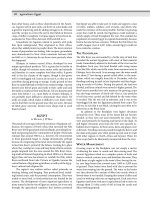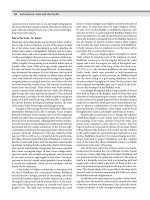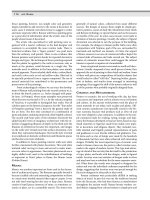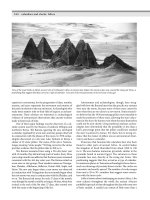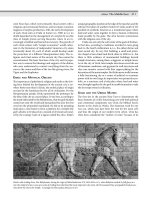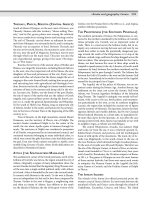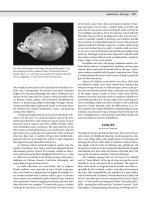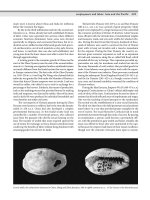Encyclopedia of society and culture in the ancient world ( PDFDrive ) 240
Bạn đang xem bản rút gọn của tài liệu. Xem và tải ngay bản đầy đủ của tài liệu tại đây (122.8 KB, 1 trang )
cities: The Middle East
cient Near East, which were primarily ritual centers with a
religious and ceremonial function, and not major economic
magnets of surplus production. Still, the early development
of such ritual sites as Eridu in Sumer (ca. 5000 b.c.e.) no
doubt depended on the management of a surplus by an elite
class of temple priests serving theocratic rulers in an increasingly stratified and hierarchical society. The growth of
such ritual centers with “temple economies” would culminate in the formation of independent Sumerian city-states
(eventually about 12), each of which would develop under
the protection of a different Mesopotamian deity. The religious and ritual nature of the ancient city thus cannot be
overestimated: The basic function of the city and its populace was to ensure the blessings and support of the deities,
who were understood to control everything from the seasons to the course and flow of the two life-giving rivers, the
Tigris and the Euphrates.
ERIDU
AND
MYTHICAL ORIGINS
The importance of polytheistic religion and myth as the driving force behind the development of the ancient city is nowhere better seen than in Eridu, the mythical place of origin
not just for the Sumerians but for all of civilization. For the
Mesopotamian people, Eridu represented the prototype for
the idea of the city as a sacred place. It was here, according to
the myth elaborated by the Babylonians, that the god Marduk
created not only the world and humankind but also the first
city from the primordial marshland. He did so by spreading
mud upon a reed frame to form a platform for a temple (the
god’s abode), to be placed on a mound of dry land surrounded by the swampy water of a lagoon called the abzu. Eridu’s
211
unique geographic position at the edge of the marshes and the
alluvial river plain of southern Sumer (15 miles south of Ur)
parallels its symbolic function as a transitional space where
land and water came together to form a human civilization
made possible by the gods. The abzu became synonymous
with the religious core of the city.
Eridu was not only the cult center of the gods of freshwater but also, according to traditions recorded in texts going
back to the fourth millennium b.c.e., the oldest shrine and
most sacred city. Its very first building, a small and primitive chapel of sun-dried mud-brick, dates to 4900 b.c.e., but
there is little evidence of monumental buildings beyond
temple structures, among them, a ziggurat, or temple tower.
As in the city of Uruk, later temple structures reveal the use
of limestone, sandstone, and gypsum for wall structures and
clay cone mosaics covered with thin copper plating for the
decoration of the main temples. But Eridu never really became
a fully functioning city or a center of political or economic
power with its own kings; its importance was primarily symbolic, as a sanctuary and a holy place where land and water
were brought together by the gods to enable humanity to take
the first steps toward civilization.
URUK
AND THE
URBAN MATRIX
The first site in the ancient Near East to demonstrate the
basic elements of a fully functioning city with both political
and ceremonial components was Uruk, the biblical Erech,
known to the Arabs as Warka. The Sumerian word for city
was uru, which may have been the root for the Latin urbs
and thus the origin of our modern term urban. Uruk has
often been considered the “mother of cities” because of its
Panels with striding lions, Neo-Babylonian, during the reign of Nebuchadnezzar II (r. 604–562 b.c.e.), when Babylon reached its full glory as a
city; this relief of a lion is one of a series of striding lions that lined the most important city street, the Processional Way, and guided ritual processions from the city to the temple. (Copyright the Metropolitan Museum of Art)
